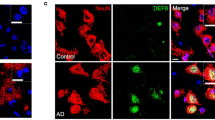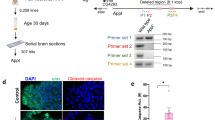Abstract
Aging is known to be the most prominent risk factor for Alzheimer’s disease (AD); however, the underlying mechanism linking brain aging with AD pathogenesis remains unknown. The expression of human amyloid beta 42 peptide (Aβ1–42), but not Aβ1–40 in Drosophila brain induces an early onset and progressive autophagy–lysosomal neuropathology. Here we show that the natural process of brain aging also accompanies a chronic and late-onset deterioration of neuronal autophagy–lysosomal system. This process is characterized by accumulation of dysfunctional autophagy–lysosomal vesicles, a compromise of these vesicles leading to damage of intracellular membranes and organelles, necrotic-like intraneuronal destruction and neurodegeneration. In addition, conditional activation of neuronal autophagy in young animals is protective while late activation is deleterious for survival. Intriguingly, conditional Aβ1–42 expression limited to young animals exacerbates the aging process to a greater extent than Aβ1–42 expression in old animals. These data suggest that the neuronal autophagy–lysosomal system may shift from a functional and protective state to a pathological and deleterious state either during brain aging or via Aβ1–42 neurotoxicity. A chronic deterioration of the neuronal autophagy–lysosomal system is likely to be a key event in transitioning from normal brain aging to pathological aging leading to Alzheimer’s neurodegeneration.




Similar content being viewed by others
References
Alzheimer’s Association (2007) Alzheimer’s Disease Facts and Figures 2007. Alzheimer’s Association Publication. http://www.alz.org/national/documents/Report_2007FactsAndFigures.pdf
Alzheimer’s Association (2010) 2010 Alzheimer’s disease facts and figures. Alzheimers Dement 6:158–194
Bergamini E, Cavallini G, Donati A, Gori Z (2007) Evidence that autophagy is involved in aging and is an essential part in the anti-aging mechanism of caloric restriction. Ann N Y Acad Sci 1114:69–78
Cuervo AM, Dice JF (1998) How do intracellular proteolytic systems change with age? Front Biosci 3:d25–d43
Cutler RG (1975) Evolution of human longevity and the genetic complexity governing aging rate. Proc Natl Acad Sci USA 72:4664–4668
Drachman DA (2007) Rethinking Alzheimer’s disease: the role of age-related changes. Curr Neurol Neurosci Rep 7:265–268
Iijima K, Iijima-Ando K (2008) Drosophila models of Alzheimer’s amyloidosis: the challenge of dissecting the complex mechanisms of toxicity of amyloid-beta 42. J Alzheimers Dis 15:523–540
Ingram DK, Nakamura E, Smucny D, Roth GS, Lane MA (2001) Strategy for identifying biomarkers of aging in long-lived species. Exp Gerontol 36:1025–1034
Ling D, Salvaterra PM (2009) A central role for autophagy in Alzheimer-type neurodegeneration. Autophagy 5:738–740
Ling D, Song HJ, Garza D, Neufeld TP, Salvaterra PM (2009) Abeta42-induced neurodegeneration via an age-dependent autophagic-lysosomal injury in Drosophila. PLoS ONE 4:e4201
Myllykangas L, Tyynela J, Page-McCaw A et al (2005) Cathepsin D-deficient Drosophila recapitulate the key features of neuronal ceroid lipofuscinoses. Neurobiol Dis 19:194–199
Nixon RA (2006) Autophagy in neurodegenerative disease: friend, foe or turncoat? Trends Neurosci 29:528–535
Okamoto K, Hirai S, Iizuka T, Yanagisawa T, Watanabe M (1991) Reexamination of granulovacuolar degeneration. Acta Neuropathol 82:340–345
Osterwalder T, Yoon KS, White BH, Keshishian H (2001) A conditional tissue-specific transgene expression system using inducible GAL4. Proc Natl Acad Sci USA 98:12596–12601
Scott RC, Juhasz G, Neufeld TP (2007) Direct induction of autophagy by Atg1 inhibits cell growth and induces apoptotic cell death. Curr Biol 17:1–11
Simonsen A, Cumming RC, Finley KD (2007) Linking lysosomal trafficking defects with changes in aging and stress response in Drosophila. Autophagy 3:499–501
Vandesompele J, De Preter K, Pattyn F et al (2002) Accurate normalization of real-time quantitative RT-PCR data by geometric averaging of multiple internal control genes. Genome Biol 3
Wolkow CA (2002) Life span: getting the signal from the nervous system. Trends Neurosci 25:212–216
Yankner BA, Lu T, Loerch P (2008) The aging brain. Annu Rev Pathol 3:41–66
Yen WL, Klionsky DJ (2008) How to live long and prosper: autophagy, mitochondria, and aging. Physiology (Bethesda) 23:248–262
Acknowledgments
This work was supported by Grants from the American Health Assistant Foundation (AHAF) and the Sidell-Kagan Foundation to P.M.S. and a fellowship from the American Federation for Aging Research (AFAR) to D.L. The authors thank Drs. Thomas P. Neufeld (University of Minnesota), Haig Keshishian (Yale University), Mel B. Feany (Brigham and Women’s Hospital and Harvard Medical School), and the Bloomington Drosophila Stock Center for providing Drosophila strains.
Conflict of interest
The authors declare that they have no conflict of interest.
Author information
Authors and Affiliations
Corresponding author
Electronic supplementary material
Below is the link to the electronic supplementary material.
Rights and permissions
About this article
Cite this article
Ling, D., Salvaterra, P.M. Brain aging and Aβ1–42 neurotoxicity converge via deterioration in autophagy–lysosomal system: a conditional Drosophila model linking Alzheimer’s neurodegeneration with aging. Acta Neuropathol 121, 183–191 (2011). https://doi.org/10.1007/s00401-010-0772-0
Received:
Revised:
Accepted:
Published:
Issue Date:
DOI: https://doi.org/10.1007/s00401-010-0772-0




